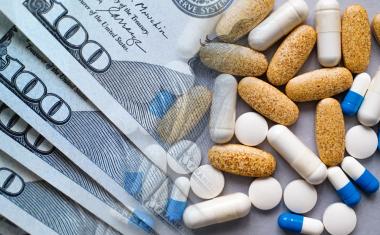The Chemical Footprint in Pharma

The chemical industry is the most important supplier of the pharmaceutical industry, but it can´t keep pace with the economic strength and R&D intensity of pharma. This underlines a report of the German economic research institute Wifor. The study measured the economic footprint of seven selected European pharmaceutical companies in the European economy and concluded that they have a huge contribution to powering growth in the business landscape.
The pharmaceutical industry is powering growth in Europe, drives employment and has a high Research and Development (R&D) intensity. These are the main results of a study from the independent economic research institute Wifor, a former spin-out of the Technical University of Darmstadt, Germany. The institute investigated the direct and indirect economic impact of seven selected pharmaceutical companies in Europe as well as their contribution to the entire European economy between 2010 and 2014.
The research also showed that the chemical industry is highly linked to pharma companies as their main supplier. With 12% of all inputs used, the chemicals sector is most prominent in this field. Together with the second largest supplier industry, basic pharmaceutical products and pharmaceutical preparations, the top two supplier industries represent almost €7 billion or approximately 20% of the intermediate consumption and thereby stand out compared to the others. As Wifor states the disproportionate increase of intermediate goods and services for production purposes is the source for high indirect and induced economic effects in the EU economy.
In the scope of the investigation, which was done on behalf of the European Federation of Pharmaceutical Industries and Associations (EFPIA), were AbbVie, AstraZeneca, Boehringer Ingelheim, Ipsen, Janssen, Novartis and Sanofi. In 2014, these seven selected companies together generated 41.3% of the direct gross value added (GVA) generated by the European pharmaceutical industry and thus represented a significant share of the whole sector. Wifor used GVA as an important factor of measuring economic strength.
The economic footprint of the pharmaceutical industry was measured in order to quantify the macroeconomic contribution of these companies to economic growth, employment and innovation in Europe between 2010 and 2014. In addition to direct economic effects, the study also accounted for indirect and induced economic effects, so-called spillover effects.
Huge Growth Impact
The analysis showed that the growth impact of the selected companies is significant. They not only contribute €34.6 billion to European GDP by generating direct GVA, but are also able to multiply this effect by a factor of 2.3. Thus, direct and spillover effects in total contribute €77.9 billion to European GDP. This means for every Euro of direct GVA by the pharmaceutical industry, 1.3 additional Euros is generated for the whole European economy.
Despite a declining direct GVA between 2010 and 2014 in Europe, the increase in total intermediate consumption shows that more GVA was generated along the supply chain, including the chemical industry. The linkages between the selected companies’ intermediate consumption and the EU economy result in rising indirect and induced effects and high multipliers.
Even on a global level the pharmaceutical industry proves to be an economic powerhouse. In 2013 it generated €330 billion of GVA, which corresponds to 3.6% of the GVA coming from the global manufacturing industry. This is combined with a high annual growth rate (CAGR) of the global pharmaceutical industry, which was 5.5% between 2005 and 2013. “Pharmaceutical companies have been striving to improve their productivity since the beginning of the new millennium. They scored early success by bringing down selling, general, and administrative (SG&A) expenses between 2004 and 2011, but more recent cost-reduction efforts have yet to reshape the structure of their P&L”, comments the consultant firm McKinsey & Company in a recent article headlined “Rethinking Pharma Productivity.”
Health Industry Makes German Economy Fit
Similar impacts can also be seen on a broader level in Germany´s health industry. An analysis of the German Ministry of Economics (BMWI) for 2016 makes clear that the health sector as cross section industry is of high and growing importance for the German economy. Such the health business contributes significantly to fulfill important core economic-politics goals. The GVA of the German health sector reached 12% of GDP in 2016, which means that every eighth Euro has been generated in this field. With a total GVA of nearly €340 billion the health sector is nearly as big as the whole GDP of Austria. Furthermore it is employer for 7 million people in Germany. The industrial health business, which includes pharmaceutical and medical device companies for example and which is one of the biggest and most important players within the health sector, generated € 71.1 billion. This was the fifth part of the GVA in the whole health sector.
As the Wifor report also highlights, the seven selected pharmaceutical companies were also able to sustain a high level of productivity and efficiency in Europe. In comparison to the pharmaceutical industry in the EU28 area, these companies achieved higher and above average levels in terms of labor productivity and GVA rates, which is the ratio between the GVA and the production value. Furthermore, the selected companies’ labor productivity is more than €73,000 higher than the pharmaceutical industry’s labor productivity.
Driver For Employment
The same holds true for employment effects. Although the number of directly employed persons decreased by 7.6% from 2010 to 2014, the total employment multiplier increased by 0.5 percentage points from 2010 to 2014. The selected pharmaceutical companies supported nearly 865,000 jobs in the European labor market making them a strong driver of employment. Throughout the labor market almost five additional European jobs were supported for each job created by the pharmaceutical industry. This shows how strong the companies are linked to the overall EU economy.
On a global scale, the pharmaceutical industry employed over 4.8 million people in 2013. In addition, the sector’s average labor productivity, i.e. an indicator of GVA generated per employee, reached €68,489.
Investment In Innovation
As a third core result Wifor highlights the pharmaceutical industry´s heavy investments in innovation. This stresses the significance of the selected companies’ R&D efforts for the Europe business landscape and that the companies make an important contribution to achieving the EU target of 3% internal R&D spending of GDP. In fact these companies have already surpassed the EU 2020 strategy´s target of a R&D intensity rate of 3% by a factor of almost six.
Wifor concludes that the high internal R&D expenditures imply a concentration of highly qualified human capital and point to a source of competitiveness through innovation. Even compared to the chemical industry, the manufacturing industry and the IT sector the pharmaceutical industry in the EU28 invests more in internal R&D per generated direct GVA. “A high investment intensity in R&D activities is seen as one key asset to master the challenges of the future faced by the European Union, such as rising labor cost, lower numbers of direct employees and the relocation of lower specialized tasks and jobs to the European outskirts”, says Wifor.
But the pharma industry faces a threat. Advances in technology and analytics are opening up opportunities for powerful tech entrants to engage with patients and consumers in radically new ways and to launch innovative healthcare offerings in conjunction with payors and providers, says McKinsey. “These entrants threaten to disintermediate pharma companies as the primary owners of patient data and take control of their value story. Should that happen, it would have drastic repercussions for pharma’s R&D and commercial models.”















